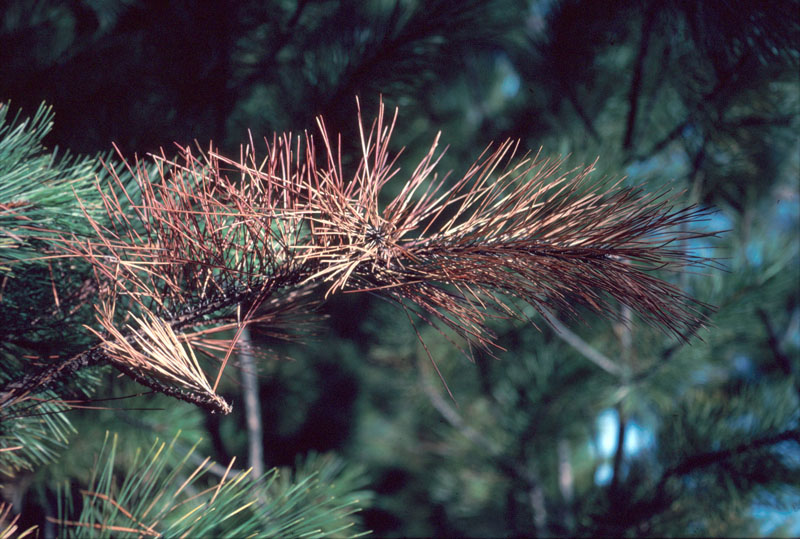Introduction
Scleroderris canker is a fungal disease that affects various conifers. It is caused by the fungus Gremmeniella abietina-Sclreoderris lagerbergii. Scleroderris canker is one of the most significant diseases of conifers. It has caused extensive mortality to conifers in plantations and nurseries, as well as in landscape and forested settings.
Two strains of the fungus have been discovered across its range. The first is the North American strain, which primarily infects young and newly developing trees. Older trees may also be infected, though they seldom incur significant damage. The European strain is more aggressive, and can infect all species of pine. Both strains can decimate susceptible conifers, causing extensive foliar dieback, and tree mortality.
Distribution & Habitat
The North American strain of Scleroderris canker has been reported in the Lake States, New York, and New England. In Canada, it is widely distributed across Alberta, British Columbia, New Brunswick, Nova Scotia, Ontario, and Quebec. The North American strain is most prevalent in locations that receive abundant snowfall.
The European strain of Scleroderris canker has infected conifers in Maine, New Hampshire, New York, and Vermont. In Canada, the European strain’s range extends across southern New Brunswick, Newfoundland, Ontario, and Quebec.
Hosts
The North American strain generally infects jack, lodgepole, and red pine. Austrian, pitch, ponderosa, and white pine, as well as black, Norway, and white spruce are also infected, albeit with less frequency. The European strain infects all species of pine. It most commonly infects red and Scots pine.
Disease Cycle
The fungus is spread via infectious spores. The spores are disseminated from April to October. Most disease cycles occur from May to July, when conditions are moist. The North American strain produces sexual and asexual spores. The sexual spores, or ascospores, develop within dark brown cup-like structures called apothecia that form on diseased twigs. The apothecia appear on dead branches in early summer. When released, both types of spores are capable of initiating the disease. The asexual spores, also called conidia, are the most efficient at doing so. The spores infect trees through their buds or needles. The infected branch tips will typically expire by the following summer.
Once a branch has succumbed to infection, fruiting structures called pycnidia arise near the base of the dead needle fascicles. During wet conditions, conidia are expelled from the pycnidia, and transported by splashes of rain or air currents to nearby trees, where they initiate new infections. The fungus rapidly becomes established in the infected plant, traveling from the branch into the main stem. As the fungus spreads, it can induce the formation of cankers, which can girdle trees. Symptoms from the North American strain generally become apparent nine months after the initial infection.
The European strain is hardier than its North American counterpart. It has a longer infection period, often producing a second crop of pycnidia in late fall. The European strain seldom forms sexual spores. However, it can release conidia at temperatures down to 21.2°F. Initial symptoms become visible two to three months following infection.
Symptoms of Infection
The North American and European strains exhibit similar symptoms. The first symptom is typically the dieback of buds, followed by needle discoloration. The needles initially turn orange-brown at the base. By mid-summer, they become entirely necrotic. Infected needles often drop prematurely. With the North American strain, discoloration occurs in early May, approximately nine months after infection. Lesions may form under the bark of infected trees. As the infection deepens, the pycnidia will become increasingly conspicuous on the dead branches.
In late July, the European strain may cause a second dieback of needles that were infected in spring. Once the fungus has infected a tree, it rapidly spreads into the main stem. Cankers that form on infected trees may enlargen. If a canker forms on the main stem, it will often deform the tree. Younger trees can be girdled, and killed within a few months. Small cankers are more common on branches infected by the European strain. They are rarely found on branches infected with the North American strain.
Management
- When planting, select resistant species. Balsam fir is immune to infection. Certain varieties of white pine and spruce exhibit an increased resistance to the fungus.
- Fungicide applications are effective at eradicating the disease. Treatments should begin in spring, during budburst. Applications should be performed at two week intervals until July, and then every four weeks until September. During years that experience heavy rainfall, additional applications may be required. Trees infected with the European strain may need to be sprayed until late October.
Additional Resources
https://www.na.fs.fed.us/spfo/pubs/fidls/scleroderris/scleroderris.htm
Photo courtesy of the Government of Canada


